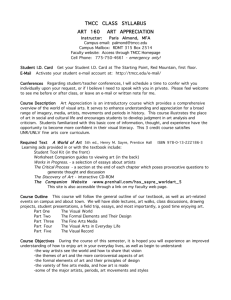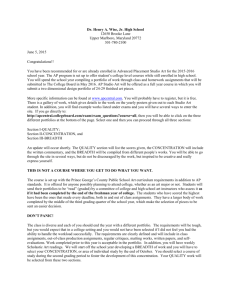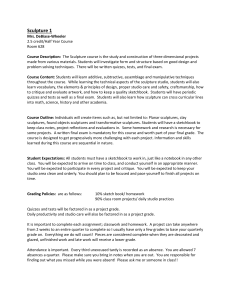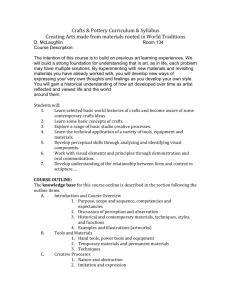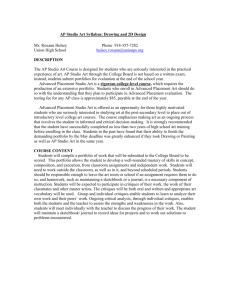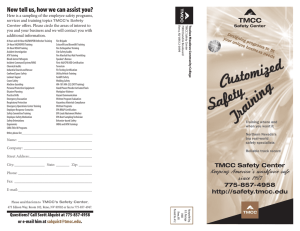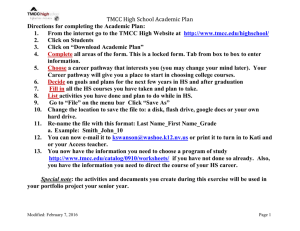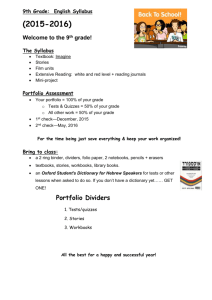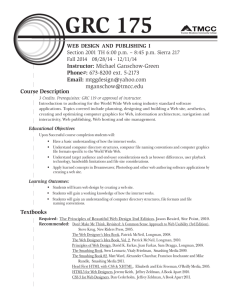TMCC CLASS SYLLABUS ART 100 VISUAL FOUNDATIONS
advertisement
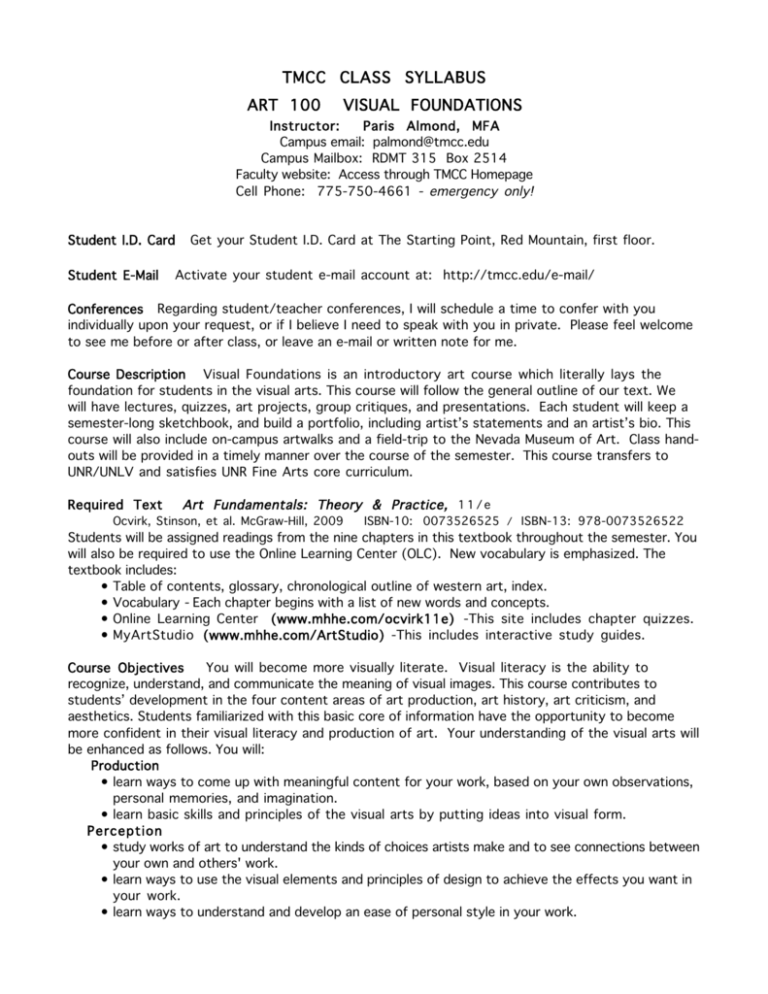
TMCC CLASS SYLLABUS ART 100 VISUAL FOUNDATIONS Instructor: Paris Almond, MFA Campus email: palmond@tmcc.edu Campus Mailbox: RDMT 315 Box 2514 Faculty website: Access through TMCC Homepage Cell Phone: 775-750-4661 - emergency only! Student I.D. Card Student E-Mail Get your Student I.D. Card at The Starting Point, Red Mountain, first floor. Activate your student e-mail account at: http://tmcc.edu/e-mail/ Conferences Regarding student/teacher conferences, I will schedule a time to confer with you individually upon your request, or if I believe I need to speak with you in private. Please feel welcome to see me before or after class, or leave an e-mail or written note for me. Course Description Visual Foundations is an introductory art course which literally lays the foundation for students in the visual arts. This course will follow the general outline of our text. We will have lectures, quizzes, art projects, group critiques, and presentations. Each student will keep a semester-long sketchbook, and build a portfolio, including artist’s statements and an artist’s bio. This course will also include on-campus artwalks and a field-trip to the Nevada Museum of Art. Class handouts will be provided in a timely manner over the course of the semester. This course transfers to UNR/UNLV and satisfies UNR Fine Arts core curriculum. Required Text Art Fundamentals: Theory & Practice, 1 1 / e Ocvirk, Stinson, et al. McGraw-Hill, 2009 ISBN-10: 0073526525 / ISBN-13: 978-0073526522 Students will be assigned readings from the nine chapters in this textbook throughout the semester. You will also be required to use the Online Learning Center (OLC). New vocabulary is emphasized. The textbook includes: • Table of contents, glossary, chronological outline of western art, index. • Vocabulary - Each chapter begins with a list of new words and concepts. • Online Learning Center (www.mhhe.com/ocvirk11e) -This site includes chapter quizzes. • MyArtStudio (www.mhhe.com/ArtStudio) -This includes interactive study guides. Course Objectives You will become more visually literate. Visual literacy is the ability to recognize, understand, and communicate the meaning of visual images. This course contributes to students’ development in the four content areas of art production, art history, art criticism, and aesthetics. Students familiarized with this basic core of information have the opportunity to become more confident in their visual literacy and production of art. Your understanding of the visual arts will be enhanced as follows. You will: Production • learn ways to come up with meaningful content for your work, based on your own observations, personal memories, and imagination. • learn basic skills and principles of the visual arts by putting ideas into visual form. Perception • study works of art to understand the kinds of choices artists make and to see connections between your own and others' work. • learn ways to use the visual elements and principles of design to achieve the effects you want in your work. • learn ways to understand and develop an ease of personal style in your work. Reflection • learn to anticipate the type of questions needed to produce better art. You will learn to ask the kinds of questions artists use to improve their own work. • learn to assess your work according to personal goals and standards of excellence in the field. Grading Points & Policy If you received the grade you were hoping for, it is probably because you achieved the objective of the assignment. Examples of these objectives may include development of skills; learning the structure of art; utilizing these principles in your projects; generating ideas; willingness to experiment; successful management of time and materials; final resolution of imagery; and presentation in critique. Attendance & Participation Quizzes Assigned Projects Sketchbook Portfolio __________________ Total possible points The “plus” and “minus” are a 96-100 A 81-85 91-95 A76-80 86-90 B+ 71-75 0 -400 points 0- 100 points 0 -100 points 0 -100 points 0 -100 points __________ 800 points = part of the letter grading scale (no A+) B 66-70 C 51-55 B61-65 C46-50 C+ 56-60 D+ 0-45 100% D DF Regarding Attendance and Classroom Etiquette ALWAYS SIGN IN! Attendance is required It is important to be punctual and attend studio art class. Attendance and participation are half of your grade, so absences do lower your grade. You will be allowed only one excused absence. As few as four absences can result in administrative withdrawal or failure. Arriving late and leaving early without prior approval is disruptive and can also be grounds for failure. Plan to be an active learner during class. Also be open to interacting often with classmates. Be mindful. Share class supplies, return them to cabinets when done, and clean up after yourself. Be conscious of your surroundings and classmates, yet focused on your project at hand. Be engaged. There is never nothing to do! Be an active learner, be attentive, take notes, bring your books and supplies. Be prepared to work in class. Speak up and participate in class discussions, critiques, & activities. Attitude is everything. We want to cultivate a learning community of classmates who are positive, creative, and helpful to each other. Studio art is experiential learning and it is very challenging. We’re involved in Process. It demands your Presence. Allow your Perceptions to Evolve! B E H E R E N O W ! Canceled Classes Access TMCC's canceled class listing at: tmcc.edu/classes/canceled/ The canceled class listing displays classes that have been canceled for the current day and/or week due to instructor illness or other unforeseen event, such as stormy weather. I will try to inform you well ahead of time if there will be a cancelation. Withdrawals & Incompletes It is your responsibility to request a “W” (withdrawal) grade if you choose to drop out. You must go online to Web-Reg or in-person to Admissions & Records (RDMT 319C) to request a “W” grade before the deadline. The instructor cannot give you a “W”. It is your responsibility to request an ‘I’ (incomplete) grade. If you complete 75% of the class with a C or better, but cannot complete the class, you may request an ‘I’ grade. This instructor is opposed to giving incompletes unless the reason is extremely compelling and accompanied by a written statement from a doctor or other professional. Quizzes - Go to Online Learning Center (www.mhhe.com/ocvirk11e) The OLC includes chapter quizzes which students should complete online, then e-mail results to me (palmond@tmcc.edu). It is important that students complete their current chapter reading homework with particular attention to vocabulary. Quizzes must be completed before undertaking corresponding project assignments. Please note: There will be a comprehensive assessment test administered online late in the semester. It is required of all Art 100 students and it will cover Chapters 1 - 9 of our text. Study for it like a Final Exam. Class Projects - Due dates TBA Our “studio day” will usually occur every Thursday, with the opportunity to continue work at home over the weekend on your own time. Be prepared to work on projects in class and at home. Assignments will loosely correlate to the chapter we’re covering. Not every assignment will be “art”, but each activity we undertake will be for a purpose. It may seem repetitive, but it is not simply “busy work”. Some projects will emphasize development of specific skills, such as drawing which is so fundamental to art making. Other projects will emphasize such topics as learning the structure of art, its formal elements and principles of design; imagination and creativity; how to generate ideas; different approaches to style; perfection and fear of failure. Students should be open to changing their habits of thinking and to experiencing new ways of seeing. C r i t i q u e s - We do not p e r f e c t art, we p r a c t i c e art! “At some point in the creative process (or in truth, at many points), there will come a need for analysis and evaluation. Criticalthinking skills will play a vital role in achieving a unified and successful work. Whether formal or informal, this review process, also known as critique, identifies what works well and helps to find constructive ways to improve troublesome areas in the work.” (Ovirk, et al, pp.27-8) Not all projects will be critiqued, but students are required to be present and participate in scheduled group critiques. This means projects must be completed prior to the critique. Late and unfinished projects will not be accepted or graded. Students may not finish projects during critique. That is rude. It is important to give and receive feedback, as art is visual communication. We need to experience the richness of insights that are possible in a group setting. Sketchbook - Due twice during semester Students are required to bring an 8x10 or 9x12 sketchbook, pen, pencils and an eraser to class. Draw at least 15 minutes every day and date your entry. You are expected to utilize your sketchbook to record ideas, sketches, inspiration, preliminary studies or thumbnail sketches, photos, and found images, etc., to do with projects in class. You will also take your sketchbook to the Nevada Museum of Art to sketch during your field trip. You should also include anything else you like, such as what you have seen and imagined over the course of the semester. You should come to expect your subconscious mind to come up with ideas and you should automatically record them in your sketchbook. Portfolio - Due at the end of semester Should you choose to pursue a career in the visual arts, you will always be glad to know you have the ability to present yourself and your body of work and assemble a portfolio, showing any future patron, client, employer, gallery or museum director that you have marketable skills, studio discipline, and unbounded imagination. Your portfolio (or processfolio) should include an artist’s biography, artist’s statements, and photographs of each of your successfully completed assignments for this class. I will not be re-grading your individual assignments, but grading the overall appearance and presentation of your portfolio as a whole. You may leave out or redo an assignment if you believe that will strengthen the weight and quality of your portfolio. If you see in your work a theme emerging, you may do well to play that up. Your portfolio should have as professional an appearance as you are capable of producing at this time. Extra Credit Opportunities 0 - 5 points possible for each submission • Enter TMCC Student Art Exhibition in April! • Write an Art Walk paper (ask for guidelines for NMA Essay and use tutoring resources) • Write about what you find in Sierra Arts, an arts-dedicated monthly publication, included in Reno News & Review. For an online calendar of local events and exhibits, visit www.sierraarts.org Student Integrity Policy Acts of academic dishonesty, including but not limited to cheating or plagiarism, falsifying research data or assisting others to do the same shall constitute cause for probation, suspension, or expulsion from TMCC. Simply do NOT hand in art projects you did not create or papers you did not write and research yourself. ADA STATEMENT “Qualified students with documented disabilities have the right to free accommodations to ensure equal access to educational opportunities at Truckee Meadows Community College. For assistance and clarification of services provided, contact the Disability Resource Center, visit our website at www.tmcc.edu/drc, come by RDMT 315 B, or call 775-673-7277, TTY 775673-7888.”
